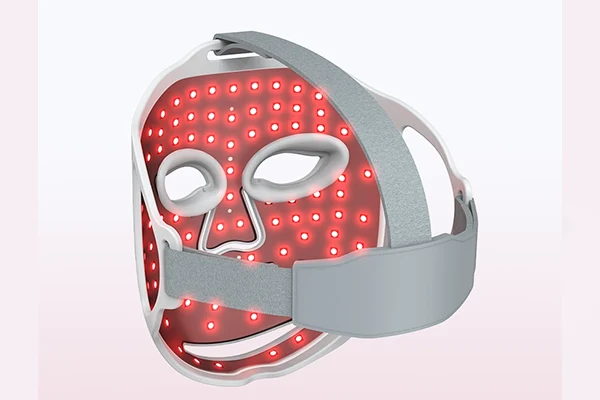Which Type of LED Mask Offers the Most Comfortable Fit?
Even the most effective LED mask can fall short if it’s uncomfortable to wear. Discomfort during use not only detracts from the experience but can also interrupt treatment routines—ultimately preventing you from achieving optimal skincare results. In this guide, we break down the comfort levels of various LED mask types to help you find the one that suits you best.
Why “Wearing Comfort” Is a Crucial Factor When Choosing an LED Mask
LED masks typically require 10–15 minutes of continuous wear, sometimes even longer. If the mask feels uncomfortable, it may reduce how often you use it, and in some cases, cause temporary skin marks or irritation. A comfortable fit is essential for consistent use—and consistent use is key to seeing real skincare results.
Types of LED Masks
Rigid Frame LED Mask
These masks use a hard plastic shell with built-in LED bulbs. They offer structural stability and even light distribution.
![]()
Flexible Silicone LED Mask
Made from soft, skin-friendly silicone, these masks conform to the contours of your face. They’re lightweight, breathable, and particularly suitable for sensitive skin types.
![]()
Topical LED Mask
Designed for specific areas like the eyes or forehead, these masks focus light therapy on problem zones. Examples include LED eye masks or “Eye Brighteners.”
Four Key Factors That Affect LED Mask Comfort
1. Material
Flexible Silicone:
Silicone provides excellent skin compatibility and hugs the face’s curves naturally. It’s lightweight, breathable, and doesn’t apply excessive pressure—ideal for those with sensitive or reactive skin.
Hard Plastic:
While this material offers solid structure and even light diffusion, it lacks breathability and may press heavily on the face. Extended wear can lead to marks or discomfort, especially around the nose and cheeks.
2. Weight
Mask weight plays a major role in comfort. Ideally, a mask should weigh between 100g–400g to avoid strain on the face and neck. Anything over 700g may lead to fatigue or discomfort during use.
Equally important is weight distribution. The best designs shift the mask’s weight toward the edges, rather than placing pressure on the nose or forehead. For instance, Wakelife’s G06 LED mask uses 3D facial scanning to ensure a snug, even fit.
3. Securing Method
Elastic Headband Style:
This design uses adjustable straps around the head to distribute pressure evenly. It provides a stable fit and minimizes ear strain—ideal for longer sessions and mild multitasking.

Ear-Hook Style:
More lightweight and compact, this style loops around the ears for quick application. However, it may cause discomfort during longer use. Better suited for short sessions or travel.
4. Facial Fit and Design Details
Adjustable Straps: Help ensure a snug but not overly tight fit for different head sizes.
Nose Bridge Grooves or Cutouts: Reduce pressure on the nose, enhancing overall comfort.
Open-Eye Design: Common in silicone masks, this avoids eye area discomfort and allows for visibility during use.
How to Choose the Most Comfortable LED Mask for You
1. Match the Material to Your Skin Type
Sensitive Skin: Go for medical-grade silicone masks. These are gentle, hypoallergenic, and lightweight—reducing the risk of irritation.
Oily/Acne-Prone Skin: Opt for breathable masks that won’t trap heat or sweat. Lightweight and ventilated designs help prevent pore congestion.
2. Facial Fit and Sizing Tips
Everyone’s face is different. Consider these points when shopping:
Larger Face Shapes: Look for masks with wide coverage and flexible edges to avoid tight, uncomfortable pressure.
Smaller Face Shapes: Ensure the mask isn’t too big, which could cause uneven light exposure.
High Nose Bridges: Choose designs with dedicated nose grooves or open nose areas for better fit.
Wakelife’s flexible silicone masks tend to accommodate a wide range of face shapes and sizes.
3. Consider Your Lifestyle and Usage Habits
Home Use: If you plan to use your mask at home, you can opt for more robust, feature-rich models—even if they’re slightly bulkier. Comfort and efficacy should be top priorities.
On-the-Go Use: For travel or frequent commuting, prioritize compact, foldable masks. These may offer fewer features but excel in portability and ease of use.
Tips to Maximize Comfort When Wearing an LED Mask
Before Use:
Clean your face thoroughly to remove makeup and oils—this ensures maximum light absorption.
Apply a hydrating serum to reduce heat-related irritation and improve treatment comfort.
Use a headband or hair wrap to keep hair out of the way and improve mask fit.
During Use:
Start with short sessions (around 10 minutes) and gradually increase duration as your skin adjusts.
Adjust straps to be secure but not overly tight—comfort is key.
For hard-shell masks, placing a soft cotton pad on the nose bridge can reduce pressure.
Try lying down during treatment to ease strain on the neck and enha
nce relaxation.
Final Thoughts
When it comes to LED masks, comfort isn’t just a luxury—it’s a necessity for consistent use and visible results. Masks made from flexible silicone, with balanced weight distribution, headband-style fastening, and thoughtful ergonomic features tend to provide the most comfortable experience. Ultimately, the best LED mask is the one you’ll actually want to use regularly. Comfort is the foundation of skincare success.

